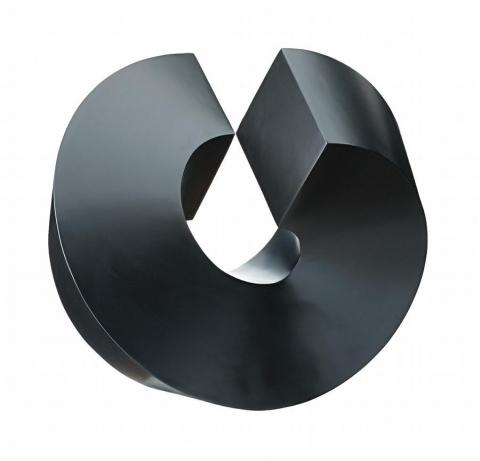SPLIT RING, 1970
CLEMENT MEADMORE
painted steel
62.0 cm height
edition of 6
signed, titled and dated on base: ‘Split Ring’ Meadmore 1970
stamped on base with Lippincott, North Haven CT foundry mark
Private collection, New York, United States of America
'...Between about 1967 and 1969, Meadmore produced a number of sculptures using the new, torsional module. In them the general configuration recalls, in whole or in part, a circle or nascent coil. Among the sculptures made at this time were U Turn, Janus and Split Ring. In works such as Curl, Spiral and Virginia, Meadmore's sculptures would extend horizontally in sometimes dense, serpentine formations...
In developing the possibilities of his new module, Meadmore made volumes turn and move through space in ways that were freer, more emphatic, and more expressive in character than previously. In the process, his sculpture became richer in feeling and more ambitious in outlook. Combined with the shift from a vertical orientation to a largely horizontal one, Meadmore brought about a wholesale transformation in the character of the object.
...Now, the combined actions of rotating the volume so that it was a horizontal, extending it and introducing more complexity all resulted in fully abstract sculpture in which the sculptural volume functioned in the manner of a line moving through space. Mass was transformed into line, and line into signified direction, an impulse of movement.
As conceived by Picasso and Julio Gonzalez when they invented constructivism, 'drawing in space' as the use of welded linear elements was termed, involved a simple denial of mass, a radical reduction of sculpture's bulk to a bare-bones scaffolding. In this new work, Meadmore simultaneously contradicts and extends that idea: contradicts it, because his 'drawing' retains, indeed is constituted by the mass characteristic of premodern sculpture; extends it, because he sets that line in motion - thus imparting to it something of the velocity of a drawn line - yet without resort to kinetics or technological tricks. Meadmore's sculptures displace, occupy space as much as had his Minimalist pieces and those recorded on the contact sheet, if only by virtue of their sheer bulk. Yet at the same time, they begin to move through space in a variety of ways, freely and gracefully...'1
1. Gibson, E., The Sculpture of Clement Meadmore, Hudson Hills Press, New York, 1994, p. 37
